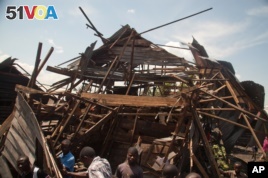August 27,2013
U.N. agencies say civilians have been victims of the latest violence in the eastern DRC. Fighting between government forces and two rebel groups -- as well as local, ethnic violence -- is also causing more displacement.

Men investigate the remains of a house struck hours earlier by deadly mortar fire, sparking angry protestors to take to the streets, in Goma, DRC, Aug. 24, 2013.
Heavy fighting last weekend between the Congolese army and M23 rebels resulted in heavy casualties on both sides. But the fighting near the North Kivu provincial capital of Goma also put civilians in the line of fire.
“At least three people were killed, five others wounded, on Saturday morning when a shell landed in Ndosho. That’s a suburb of Goma. And Goma at the moment is apparently packed with civilians because more than 150,000 people have been displaced towards and around the city since the fighting started in 2012,” said Daniel MacIsaac, spokesman for the U.N. refugee agency, UNHCR.
Others at a nearby displacement camp were also at risk.
“Another shell fell Saturday near the Mugunga 3 camp. And that shelters 14,000 internally displaced people. -- Congolese that had to flee their homes because of fighting. Meanwhile, two days before this, on Thursday, again we’ve got reports numerous shells landed in a residential area of Goma killing at least four people and wounding 15. And all of those were civilians, too,” he said.
UNHCR and other agencies are warning warring parties that indiscriminate or deliberate attacks against civilians are war crimes.
The Goma area is not the only conflict zone in the eastern Congo. Further north, the Congolese army is fighting the Ugandan rebel group ADF, or Allied Democratic Forces. About 50,000 people fled the area in mid-July and crossed the border into western Uganda. The UNHCR has set-up a transit center at Bubukwanga. It has a capacity to handle up to 12,000 people. The problem is there are as many as 20,000 refugees there.
“So it’s been a strain on the local communities. People were staying in schools for a while – the refugees on school grounds,” said MacIsaac.
The U.N. agency has so far transferred about 3,000 of the DRC refugees to the Kyangwali Refugee Settlement further from the border.
“One of the many good things about Uganda hosting so many refugees is that they don’t necessarily just live in camps there, like you envision a refugee camp with tents. They actually are quite open and have freedom of movement in Uganda and they have refugee settlements. They don’t look so different from a typical rural village in Uganda,” he said.
Besides the two current conflict zones in North Kivu Province, there’s also been a flare-up of local disputes over land and other issues in the Ruzizi Plain. That’s on the border of South Kivu Province and Burundi.
MacIsaac said, “Over the last 12 days or so, we’re seeing 1,500 Congolese asylum seekers fleeing into their neighboring country, in this case, Burundi. This is more low-level ethnic fighting. And what they’re telling us, the people who are coming across, was that unidentified armed people killed about eight people and seriously wounded many more and again in the last two weeks.”
The UNHCR said that the asylum seekers are staying temporarily at the Cishemere Transit Center in Burundi’s western province of Cibitoke. Some have been transferred to a refugee camp.